Beyond Italian: A Thorough Guide to the Languages of Italy
Are you feeling smug because you know how to order pasta in Italian? That might be enough for the casual traveller, but if you really want to impress your Italian family or coworkers, you’ll have to master not only the standard variety but also know the basics of the different Italian dialects.
For example, if you go to Naples, you can order a regional dish like the octopus in broth, and do it the way the locals do it: o’ bror’ e purp’, instead of just saying “brodo di polpo” and sound like one of those speakers in Italian textbooks.
Let’s see how you can experience Italy like a local with our overview of the main dialects of Italy!
Table of Contents
→Sign Up Now: Free Trial Italian Lesson With a Native Teacher!←
Fantastic Italian Dialects and Where to Find them
The official language of Italy, of course, is Italian, which has 67 million native speakers. However, regional dialects are so distinct and prominent that, when discussing the linguistic situation in this country, one should rather talk about the languages of Italy.
Italian dialects, for the most part, are spoken by people who also speak the standard variety as a second language, which means that many Italians are actually bilingual. Some of these variants (Sardinian and Sicilian among them) are quite distinct from Standard Italian, which makes them unintelligible to speakers of other varieties.
These dialectical differences are the result of a succession of migration flows that Europe has seen in the last centuries. This means that, as a result, we can find Italian speakers in other European countries, albeit among minority groups.
So, what are we waiting for? Check out this map to see how diverse are the languages of Italy!
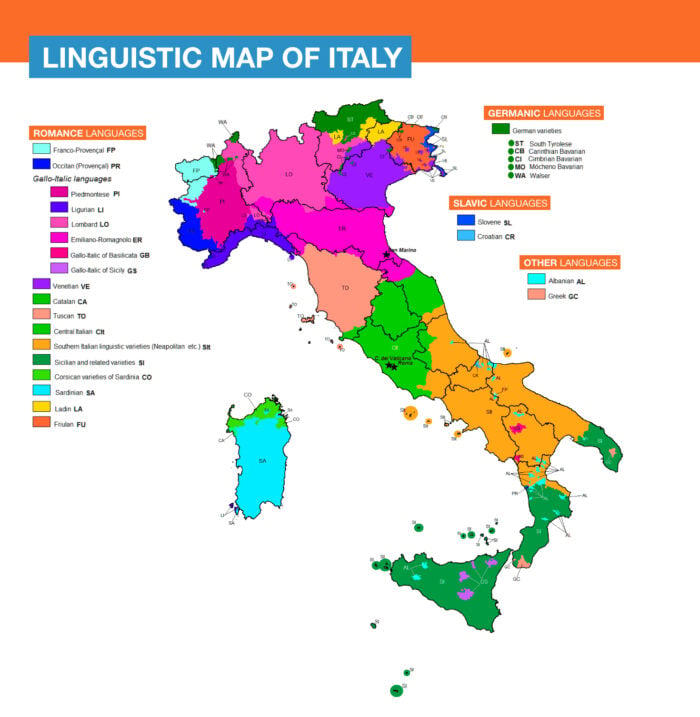
Italian Dialects or Regional languages?
So, wait a second. Should we talk about Italian dialects or about the languages of Italy? What’s the real difference between a language and a dialect, anyway? According to most sociolinguists, there isn’t one, actually.
The fact that some varieties are considered dialects and not languages has more to do with ideology than with language. Calling Sicilian a dialect and Standard Italian a language shows which variants (and therefore communities) a political power chooses to recognise and empower.
Linguists usually avoid controversy and use the two terms interchangeably. When they do distinguish between the two, it’s based on levels of mutual intelligibility.
If speakers of two Italian dialects understand as much and no more than Portuguese speakers would understand Spanish, we should call them languages rather than Italian dialects. And indeed, Northern regional languages are much more similar to French and Occitan than to Standard Italian or any other of the languages of Italy.
Standard Italian
Italian, like French and Spanish, is a Romance language and a direct offspring of Latin. What we call the modern standard variety of Italian descends from the Tuscan language of Florence as spoken in the 14th century.
The impulse towards linguistic homogeneity was given by such intellectuals as Dante Alighieri and Pietro Bembo, who wrote their most important works in Tuscan and thus helped cement its dominance.
Thanks to the people like Alighieri and the political and cultural relevance of Florence at that time, Tuscan emerged as the undisputed national language.
In 1454, a manuscript was published in which the vernacular language was codified for the first time in an attempt to challenge the supremacy of Latin.
Today, Standard Italian is the official and most important language in Italy, being taught in schools, broadcast on TV and the radio, used in all formal contexts, and spoken by educated people.
Italian is also a major language in Switzerland, San Marino, and Vatican City, and it has official minority status in western Istria (Croatia and Slovenia).
The Other Languages of Italy – An Overview
Besides Italian, there are approximately 34 other native languages in Italy. So, while it would take a much longer article to list every dialect and language spoken in Italy, below you will find a few of the more important ones to be aware of if you’re planning to travel around this wonderful country.
Neapolitan
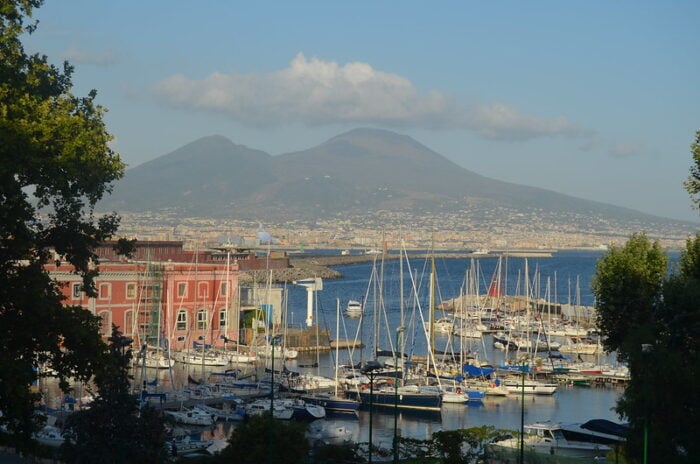
Photo of Naples by Pedro via Flickr.
Neapolitan, often described as the most important of all Italian dialects is common to Naples and the surrounding area, and is one the most widely spoken varieties in Italy after standard Italian.
Many celebrated Italian songs (like O Sole Mio) are in fact Neapolitan. Familiarising yourself with the sounds of this language will help you understand people from Naples even when they’re speaking the standard variety.
For instance, here are some common words in this language that will help you see how different it is from Standard Italian:
- Italian: Napoli
- Neapolitan: Napule
- English: Naples
- Italian: straniero
- Neapolitan: furastère
- English: foreigner
- Italian: pomodori
- Neapolitan: pummarola
- English: tomatoes
Learning Neapolitan is very enjoyable because its proud speakers love getting creative with it and, as a result, you can find lots of colourful local phrases.
These are some of our favourites:
- Jamm checazz’ — This one means that things are going great, although it’s usually used in an ironic way.
- Azz! — A common expression of both dismay and delight.
- Nun sacc’ niente — I don’t know anything. (It’s always useful to know at least one humble phrase of defeat)
- Liev’t a miezz’! — Get out of my way! (Usually said by drivers and cyclists during the chaotic rush hour in Naples)
Sicilian
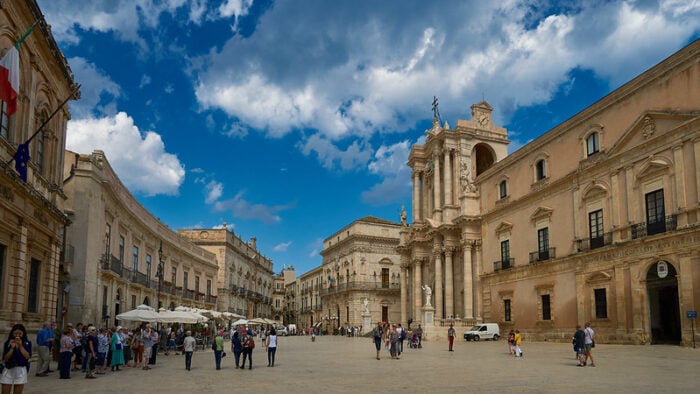
Piazza Duomo in Sicily, by Radek Kucharski via Flickr.
Spoken on the island of Sicily and also as a variant in southern Calabria, Sicilian has its origins in Latin, Arabic and Greek, with some German and Catalan influences.
Of all the languages and dialects of Italy, Sicilian is the one that has the most interesting phrases. For example:
- Annacamento: This Sicilian term, which has no direct translation in Italian or English, means ‘maximum movement with minimum displacement’, and was originally used as a metaphor by author Roberto Alajmo to describe a journey around Sicily.
- Troppu trafficu ppi nenti: This is a must-know expression for people interested in Sicilian culture. It comes from the myth that says Shakespeare was actually born in Sicily! Playing around with this wild theory, people turned “Molto rumore per nulla” (Much Ado About Nothing) into Sicilian.
- Quaquaraqua: A quaquaraqua is one of those words which have a perfect sound for the meaning they convey. It means a ‘quack’, a ’chatterer’ or a ‘blabber’!
If you’re curious about Sicilian, listen to Franceso speaking in this language! He’s a local Siciliano who loves sharing information about his dialect.
Friulian
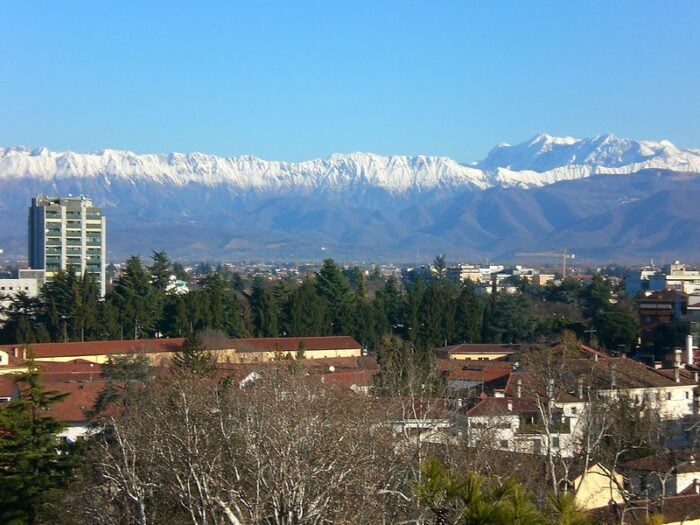
Photo of the Northeaster Province of Udine, Italy, by antony_mayfield via Flickr.
Friulian is a Romance language (not an Italian dialect) belonging to the Rhaeto-Romance family, spoken in northeastern Italy. Spoken by 600,000 people, most of whom also speak Italian, Friulian was shaped under the influence of languages, such as German, Venetian, and of course, Italian.
Though they are distantly related, Friulian and Italian are not very similar to each other. Let’s see how distinct these two languages are.
Examples:
- English: Hello, I’m Susie!
- Italian: Ciao, Io mi chiamo Susie!
- Friulian: Mandi, jo mi clami Susie!
- English: The weather is hot today!
- Italian: Oggi fa caldo
- Friulian: Vuê al è cjalt!
- English: I have to go now; see you around!
- Italian: Devo andare. Addio!
- Friulian: O scugni propit lâ cumò; ariviodisi.
Sardinian
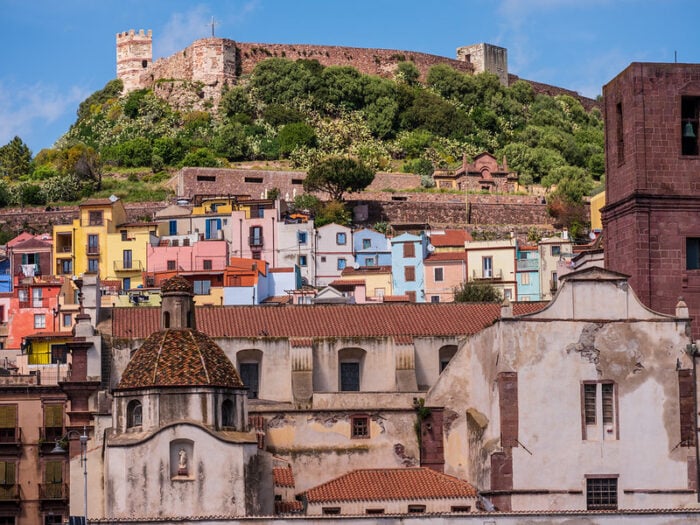
Photo of Sardinia, Italy, by Greg Johnson via Flickr.
Extending across most of the middle and south of Sardinia, this is one of the most important languages of Italy. Spoken by approximately 1.3 million people worldwide, Sardinian is more popular among senior citizens than with younger generations, which is why Unesco has classified it as an “endangered” language.
Of all Italian dialects and languages, Sardinian is the closest to Latin, and it also contains echoes of Greek, Spanish and Catalan.
If you’re planning to visit Sardinia, make sure you say hello the right way:
- Coment‘ istas? – “How are you?”
- Ite paret? /ite pàrede”/ – Literal meaning: “How does it look?”, similar to “What’s up?”
- Ebé – not to be confused with Italian “embè?” (which means “and so?”). Ebé means “Hey mate!”
As you can see, there’s more to Italian languages than meets the eye. If you are a language enthusiast, travelling to Italy will give you the rare chance of practising lots of different dialects in only one country.
→Sign Up Now: Free Trial Italian Lesson With a Native Teacher!←
Did all this Italian talk make you yearn for the musical sounds of this language? Then check out our list of the most incredible Netflix shows and films in Italian, and of course, our list of great podcasts to learn Italian.
So, do you want to delve deeper into Italian or any of the languages and dialects spoken in Italy? Reach out to us now and we’ll pair you up with a native Italian teacher so you can start learning right away!
This article was updated on 29 June, 2023.


